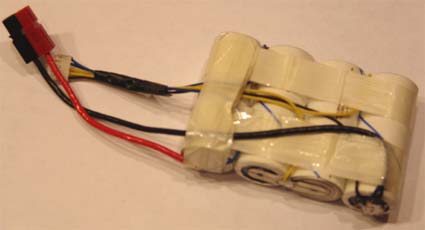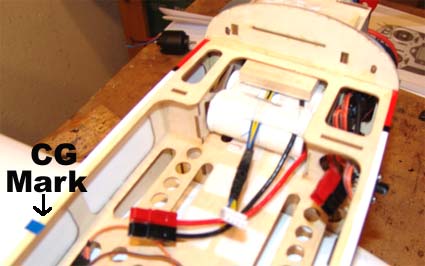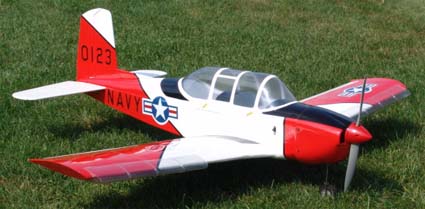|
By Ken Myers July 30, 2008 The following is what I posted and what the link in the title will open. From the Manual:
I am that "qualified instructor". I have read all 37 pages of this thread so far, and wished I had read them before I recommended this plane to a person who became one of my most recent students. This plane has been a "pain" since our first outing at the field. On the first day, there was no flying of the T-34 because the ESC would not arm, and on the very, very rare occasion when it would, it did not function "properly" and at WOT could only turn the prop at 5300 RPM. (Bad ESCs were noted in this thread.) Thanks to a very accommodating manager at Rider's Hobby Shop, the whole fuselage, including a new speed control was "switched" for the defective one. The original fuselage, as received, had a hole in the side of the covering, as well. They did the whole switch and setup in the store. Great Service Riders! Unfortunately, the second trip to the field had several problems as well, and ended with no stick time on the T-34 for the student. The student kept the same canopy/hatch and it absolutely does not fit on the new fuselage. No, it is NOT the cowl that is keeping it from fitting, as noted in this thread. The black stripe on the front of the cowl does not line up with the one on the fuselage, which was only an indication of the &qot;real" problem. The canopy/hatch magnets do not line up and the canopy/hatch will not stay on the aircraft. His original canopy/hatch is slightly longer than the one that must have been on the new fuselage.
The first time I took it for a "trim flight", I could do no trimming. The student had the flaps fixed at the maximum deflection and the wing has the droops on. Shortly after takeoff, and with the plane not at full power, it was climbing at what I perceived as a precarious angle. At first I thought it might be very tail-heavy. I had checked the CG against the recommended CG in the manual, which he had thoughtfully brought to the field, and the CG fell within the recommended range, but it sure was flying "tail-heavy." I tried to add some down trim, but I could not find the elevator trim lever/button. Somehow it did not naturally fall where I expected it to be, and with a "handful of plane" I could not look for it. I landed the plane to take a look. The battery had shifted a bit towards the rear. The battery was still under the provided strap, but there was no hook and loop fastener on the battery and the battery tray. We used an object that we had available to "hold" the battery in the farthest forward position. On the second "trim flight" I made sure I could "find" the elevator trim lever. We also moved the flaps to the second position from maximum deflection. With about 10 clicks of down trim and a couple of clicks of aileron trim, the plane felt a bit more under control, but still felt like I was flying a balloon. It was very unnerving. While I had little confidence in the plane, it did nothing really odd, but just felt odd on the sticks. After that couple of minutes of flight, I landed and we checked the CG once again. It seemed okay and the battery had stayed in place with our field modification. I took it up for one more "trimming flight", but it still had a "funny" feel to it. We decided to call it quits and see if we couldn't get some of the problems taken care of before our next session. I told my student that I would check RC Groups and see what I could find out about this plane. I found out, in this thread, that the default setup for this plane includes "Expo". Ah, the flying a balloon was explained. I'm not a huge fan of Expo and never use it, but I can understand, sort of, why the supplier might have set up this plane that way. At least now I know why I can't stand the way the plane reacts in the air. It is not the airframe. It is the transmitter setup. We are now faced with a HUGE obstacle. I have absolutely no way to buddy box my student, and he will need it to successfully fly this plane. Our club does have the JR training box/Tx and trainer cord, which work with the Spektrum system, but the buddy box has none of the features that his Spektrum, by default, is setup with. I could get the appropriate trainer cord and patch cord to use my Hitec Eclipse 7, but that doesnÕt seem like a good option, since he won't be flying "his" transmitter and learning the "feel" of it. For the time being, I can see the only solution to the problem is to set up his Spektrum as a "straight" radio with no Expo, dual rates or anything else that may not be available on our buddy box Tx. Therefore, I believe it would be better if the initial setup of the included Spekrum were set to a default of no Expo and no dual rates. If I purchased a Spektrum system, I suppose that it would help, but I would never purchase a Spektrum radio. While I know they are extremely popular, I have very little respect for a company that knowingly markets a radio receiver that can "shut down" due to low voltage and not reboot in time to keep a plane from crashing. Yes, I know that is supposedly fixed now. I would never purchase a radio that has a fuse in it that is not noted in the manual and causes folks from all over the world to have to send their radio in to have a fuse changed, simply because it was never documented. Spektrum also marketed a transmitter charger that could not charge at the "expected" C/10 rate in the usual 12 to 14 hours and actually took (may still be taking) about 20 hours to charge. This led to many transmitter batteries being "under charged."
No, I'm not living in the dark ages, and I do realize that 2.4Ghz is the future, but not yet for me. Yes, I highly recommended the purchase of 2.4Ghz technology to those entering the hobby. I think it is a wise move. Unfortunately, it is kind of backfiring on me, as I will soon be working with another student who has just purchased a Futaba 2.4Ghz system. As I type this, I believe that maybe the best solution would be for me to purchase a "trainer" receiver. I would put my "trainer" receiver in the student's plane, create a trainer plane in my Eclipse 7 memory, and use the student's 2.4Ghz as the buddy box. Just a thought. I'm kind of wondering how other instructors, who do not have 2.4Ghz systems, plan on solving this "problem." Maybe it is not a problem for anyone else as I may be the last troglodyte instructor left on the planet. There is a problem with his charger. It appears to be working okay, sort of, but his does not have the alligator clips that are currently shown on the Horizon Web site for the supplied charger. His has a plug that goes into a "cigar" lighter socket in a vehicle! When I saw him charging his battery on the seat of his $30,000 plus SUV I couldn't believe it.
I realize that many of these issues are MY issues, but I am still not very happy that I recommended that he purchase this system. It hasn't started "working" for us yet. Fortunately, my student has gotten many flights on the EasyStar RTF that I bring with me to the field whenever I'm working with new students. He's doing very well with it now, and not lost total interest in this hobby, yet. I am determined to make this T-34 work for him/us, but the frustration level for both of us has been quite high. Still, any day at the flying field is better than any day anywhere else. The following links are responses to my post, as well as follow up posts that I made. Agrees about quality control lacking at Horizon Hobby Couldn't understand the buddy box problem Didn't understand the buddy box problem - says some less than helpful things Thinks its fine plane but not a trainer - had same ESC problem post by me stating what is in the manual for the supplied radio I restated what manual said and asked poster Smacka why he'd not respond to some of my comments Still talking about the buddy box problem. Discussion of problem with the NiCad charger for the DX6i Poster Smacka responds that my comments were an "absolute crucifixion" of the T-34 PTS __________________________ Before I continue with the saga of trying to use this plane as a "trainer", I am inserting these comments on September 15, 2008.
__________________________ In one of his posts, Smacka suggested, "I would like to see you step back and give it a week or so for you to calm down. Then read your post again. I'll bet it will change." That's what I did. On Saturday, August 2, Jim Young took up the plane for a flying CG checkout and trim flight. 4 oz. of nose weight had been added and hook-and-loop fasteners added to the battery and battery tray to hold it securely in position, as it should have been in the first place. It should be noted that the battery tray broke loose from the airframe in one place when the hook-and-loop fasteners were pressed into place. Some CA took care of that problem at the field. Jim flew the plane around a bit to get the feel and then performed the dive test to check the CG. With the battery as far forward as physically possible and 4 oz. of nose weight it appeared to be just about neutral with an ever so slightly tail heaviness, not exactly the best for training. Several more dive tests were done, with the same results. Remember that the flaps are fixed and the droops on.
I believe that flying the plane with the flaps extended, as suggested in the manual for a beginner, changes the relative CG, and this was not taken into account in the design and equipment placement for good "balance". The NACA droops do compensate for what happens, but it makes the plane a bit harder to control, especially for a beginner. After noting that the CG was "better", and with a fresh charge on the battery, I took the plane up, got the feel of it, and my student got a few seconds on the stick several times. The wind had come up a bit after our second flight, so we decided to hold off on the training using the T-34. On Sunday, August 3, I met my student at the field in the morning and we had two flights where HE determined that the plane is too much for him right now, since we can't buddy box it. We continued to "train" on the EasyStar RTF. The buddy box still continues to be an issue for ME. On Tuesday, August 5 at 11:18 a.m. I sent an email titled "Spektrum DX6i Buddy Box Question" to productsupport@horizonhobby.com "Hi, I tried calling tech support with this question, but that was a bust. That is some horrible, loud music you have on that line while a person is on hold! Guess that is just to keep folks from holding too long. Hopefully someone will have an answer via email. My RC student has an E-flite T-34 Mentor with a Spektrum DX6i. In the radio manual it says that it can only be buddy boxed to another DX6i. Is that correct? If not true, what other transmitters can it be buddy boxed to? What buddy box cord(s) can be used? Thank you, Ken Myers" Yeah, I know, that part about the music was rude, but if youÕve ever called Horizon Hobby tech support, you know what I mean! The music is so loud that it was overdriving the little speaker in the earpiece of my regular house phone. I know, take a breath, count to 10. You can catch more bees with honey than vinegar. No response yet on Thursday, August 7 after 11:18 a.m., which is 48 hours later. I know they receive the email, as I received an automated response from their system. In post http://www.rcgroups.com/forums/showpost.php?p=10263290&postcount=589
Everyone is entitled to his or her opinion, and I sincerely respect his, really, but I do not believe that what I stated was an "absolute crucifixion" of the Mentor T-34 PTS.
Here is a summary of what I said in my original post
Again, I say, I don't believe I have crucified this model, I've simply pointed out several facts, one of which I noted was in error, and I have given my opinions. I am not a dealer or hobby shop owner and I don't have any connection with Horizon Hobby. I have no axe to grind with Horizon Hobby or E-flite. I have never been "done wrong" by anyone connected with either organization. I have nothing to gain or nothing to LOSE by letting others know what I believe that I have learned about this plane and its use a trainer for a beginner. I believe the videos, and posters when they have responded, showing and telling how well this plane flies. All I have been trying to point out is that it is not working for us as a basic trainer with an instructor, as advertised. On August 21, 2008 I did receive a reply from Horizon Hobby about the buddy box. It read, "Thank you for your recent email. The DX6i can be buddy boxed with any computerized JR or Spektrum transmitter using a Spektrum or JR trainer cord. If you have any further questions please feel free to give us a call at 1-877-504-0233. Chris Puckett
September 15, 2008 Update: Chuck and I finished setting up a flap servo yesterday in the T-34. We are anxious to get this bird back out to the field and try it again. We may also have a buddy box to use as one of my other flight instruction students now has two Spektrum transmitters. Update, Sept. 17: Back on July 30th I posted how I felt about this plane as a trainer. (see comments at beginning of this article) We've been able to take care of the buddy box problem that I mentioned because one of my students now has two Spektrum radios, so we can borrow one to use with the student who owns this plane. Very few of the posters in this thread have used this plane as a teaching tool and tried to use it with the fixed flaps and droops. The majority of the folks are flying it as a "sport" plane and they've noted how well it flies. We finally got a flap servo installed, and I must absolutely agree that this plane is delightful to fly! I still feel that flying it around with the flaps "fixed" makes this plane much harder to fly and train on than with the flaps up. Of course, that's just one person's opinion. The bottom line is that we are going to be able to now progress using this plane. The only "problem" that we have now is that it takes so long for my student's Li-Po to charge on my CellPro 10S, which is much faster than the supplied charger, that we can't get many flights at the field during a given flying session. That little glitch should soon be taken care of as I'll be making him a 4S "A123" pack for this plane. Hopefully Horizon Hobby will take care of the real "teething" problems with this plane soon, as it is a "winner". October 2008 As I mentioned in October 2008 issue of the Ampeer, one of my flight students has this plane. He decided that he wanted to use the 2300mAh cells from A123 Systems, Inc.
 Next, I made an adapter for the power leads of the E-flite 40-Amp Pro Switch-Mode BEC Brushless ESC so that Anderson Power Poles (APP) and the original connector provided by E-flite could both be used.
 The next task in converting to a 4S1P "A123" pack was to get the correct center of gravity (CG). We had added 3.67 oz./104g of lead stick-on weights to the top of the motor mount box, and the plane was flying "sort of okay", but I wanted to try and get the lead out by using the heavier cells and knowing the correct center of gravity (CG). The supplied 3200mAh Li-Po pack weighs 8.78 oz./249.05g and the new "A123" pack 11.34 oz./321.5g.
 The "A123" pack uses VelcroTM on the bottom of the rear cell and a balsa wedge to hold it in place. There is very little room in the battery area for the cells to move side to side. That means it is a TIGHT fit!  Drive Calculator (www.drivecalc.de) did not have the supplied E-flite Power 25 BL Outrunner Motor, 870Kv motor in its database (I've since added it), but I used another typical outrunner of about the same weight and Kv that E-flite says the 25 has to estimate what prop I might want to use. It looked like an APC 12x7 sport could work with the supplied 40-amp ESC, especially if I lowered the timing of the electronic speed control (ESC).
This motor was static tested on a sunny day with the ambient temperature being about 70-deg F/21-deg C. The elevation here is about 980 ft./298m above sea level. The ESC was the supplied E-flite 40-Amp Pro Switch-Mode BEC Brushless ESC was set to a 5-deg advance. (The standard timing is 15-deg.) The numbers presented here are averages for five captures approximately 5 seconds apart. No Load 1: 9.924v, 2.09 amps, 8688 RPM
The following day I did the weights and measures and came up with the following information.
The weights and power are just about equivalent and produce a stall speed of about 17.5 mph and a pitch speed to stall speed ratio of about 3 to 1. 
Chuck's T-34 From the threads on RC Groups about this plane, it seems that most of the folks purchasing this plane are not using it as a trainer.
To Reach Ken Myers, you can land mail to the address at the top of the page. My E-mail
address is:
KMyersEFO@theampeer.org
|